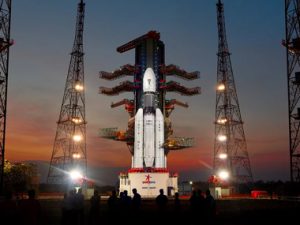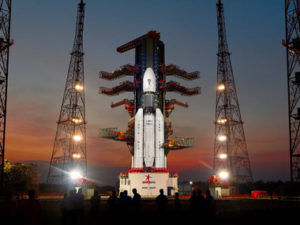
PM Lauds ISRO Efforts In Successful Launch Of GSAT-6A Satellite
New Delhi: The Prime Minister Narendra Modi lauded the efforts by the ISRO team for the successful launch of GSAT-6A satellite by hoping that the new satellite will prove to be a window for new possibilities for mobile applications. He further congratulated the team for their collaboration for the mission.

“Congratulations to ISRO and other stakeholders on the successful launch of GSLV-F08 with indigenous cryogenic stage. GSAT-6A, a communication satellite, will provide new possibilities for mobile applications. Proud of ISRO for taking the nation towards new heights and a brighter future,” he said.
India on Thursday launched its satellite named GSAT-6A successfully. The new satellite would help provide mobile communication facilities by using its heavy rocket Geosynchronous Satellite Launch Vehicle (GSLV-F08).

The satellite was developed by ‘The Indian Space Research Organisation’. The launch place was selected for the satellite was Satish Dhawan Space Centre located in Andhra Pradesh’s Sriharikota. The timing for the launch was set for 16:56 hrs (4:56 pm) IST.
The satellite prior to this one was GSAT-6 and this one too along with GSAT-6A is a high power S-band communication satellite.
The GSAT-6A comes under the category of high power S-band communication satellite. After the launch, it is second predominantly S-band communications satellite. The earlier one GSAT-6 is in orbit since August 2015 at 83 degrees East longitude.
The satellite was built with purpose to provide platform for emerging new technologies. ISRO Chairman K Sivan has already confirmed that the GSAT-6A launch would soon be followed by the launch of another navigation satellite which will happen in the next fiscal.
According to the space agency ISRO, GSAT-6A mission will last upto 10 years. The cost of the satellite project weighing about 2-tonne, is approximately rupees 270 crores.
The satellite also has ‘unfurlable antenna’ measuring six-meter in width and looks similar to an umbrella. Once the satellite GSAT-6A reaches its orbit, the antenna can be ‘unfurled’. This antenna is very special one which was designed for the mission and compared to other antennas of ISRO, this one is three times broad. The antenna helps in enabling mobile communication from anywhere through hand-held ground terminals. Apart from the communications facility, the design of GSAT-6A satellite is to help military purposes.
S-band is an electromagnetic spectrum having frequencies which range from 2 to 4 gigahertz (GHz). It crosses the conventional boundary lying between the Ultra High Frequency (UHF) and Super High Frequency (SHF) bands allotted at the rate of 3.0 GHz S-band is used by weather radars, surface ship radar, and also by some other communications satellites. S-band is very useful because the 2.5 Ghz band is specially used around the globe for 4G services, and is worth billions of dollars. The S-band spectrum is also considered to be extremely valuable for mobile broadband services.
You May Also Read: ISRO’s GSAT-6A To Be Launched On March 29 – Find Details